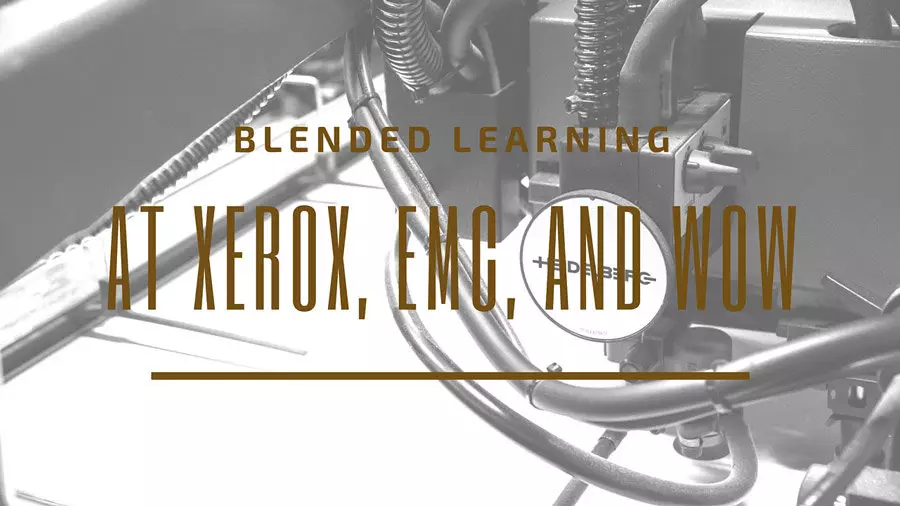Blended Learning at Xerox, EMC, and WOW

Even though face-to-face learning remains the preferred modality for training throughout much of corporate America, accounting for 51% of all corporate learning hours delivered, the numbers related to learning retention are downright depressing. According to one Corporate Executive Board study revealed that seven days after a formal training, learners had already forgotten 70% of the content. Follow-up again in four weeks and they will have forgotten 87% of the content. What to do? Blended learning might just be the answer.

Successful blended learning in the 21st century can’t just be an extension of what’s been tried so far. The point is to take it in directions that fit with Millennials being digital natives, which means highly mobile, social learning that can happen anywhere and everywhere, but especially in real-time on the job and in collaboration with the people around them in an instantaneous blending of the theoretical with the practical.
That’s the new focus in blended learning – combining learning and application on-the-spot. It depends heavily on both virtual learning networks but also on well-structured peer support networks. What this translates into on the ground can be thought of in three essential components as explained in a recent article in Chief Learning Officer magazine: Learning communities, learning cohorts, and learning pairs.
A learning community is designed to support the learning-on-the-job aspect in this approach to blended learning. It consists of some number of employees who all share a development area to be addressed, and the topics tend to be relatively basic information everyone needs to know. The learners can access the content and activities essentially at will. One area where this concept is easily applied is onboarding, wherein the learning community is made up of new hires from throughout different areas of the company. Members come and go as they see fit according to their availability and specific needs. Technology is leveraged to help the learners figure out who to turn to for specific learning assistance, as well as to shape the body of content and prioritize resources.
Xerox is one company that took the learning community concept to heart and ran with it in its Xerox Services University. The university is made up of five different schools such as Creativity, Innovation, and Business Foundations, with each one being aligned with a key competency Xerox wants all its employee to have. Algorithms govern suggestions for users on which groups the might join and what content they may find useful. Members of the specific learning community support each other as fellow practitioners to share lessons learned and best practices.
Learning cohorts help with on-the-job action. The tend to be much smaller than learning communities, typically with fewer than a dozen members, and zero in on specific L&D goals, agendas, and curricula under the tutelage of an adviser for the group. Learning is applied immediately in work, making it a highly personalized process. Group activities are mandatory because sharing with each other about how the application of learning went is a key driver of the process.
EMC, the rapidly growing data storage company, engaged in the learning cohort concept in its use of blended learning for new technical support engineers hired into the company. Face-to-face instruction is supplemented with social learning opportunities wherein everyone learns from everyone else, all in the service of resolving customer problems as quickly as possible. In its program, it’s the learning cohorts that are the virtual part of the blend, fostering peer collaboration and dialog. This virtual aspect meant up to four hours of saved time per participant, and financial savings of $270,000 by avoiding the cost of some face-to-face activities.
Learning Pairs are designed for on-the-job guidance. It’s a one-on-one relationship between the learner and instructor, who may be a mentor, coach, supervisor, or peer adviser that turns the focus to learner-specific, goal-driven learning activities. The advantage is more immediate feedback as learning is applied to the daily job.
Wide Open West (WOW), a telecommunications company, makes use of this learning pair concept as a way to replace outdated performance management systems with something that delivers frequent constructive feedback to participating learners. In this approach, performance management is transformed into an ongoing dialog.
These are just three real-life examples of how new approaches to blended learning are being born throughout corporate America all the time. Perhaps your company will usher in the next big idea in blended learning.
Other articles on blended learning: